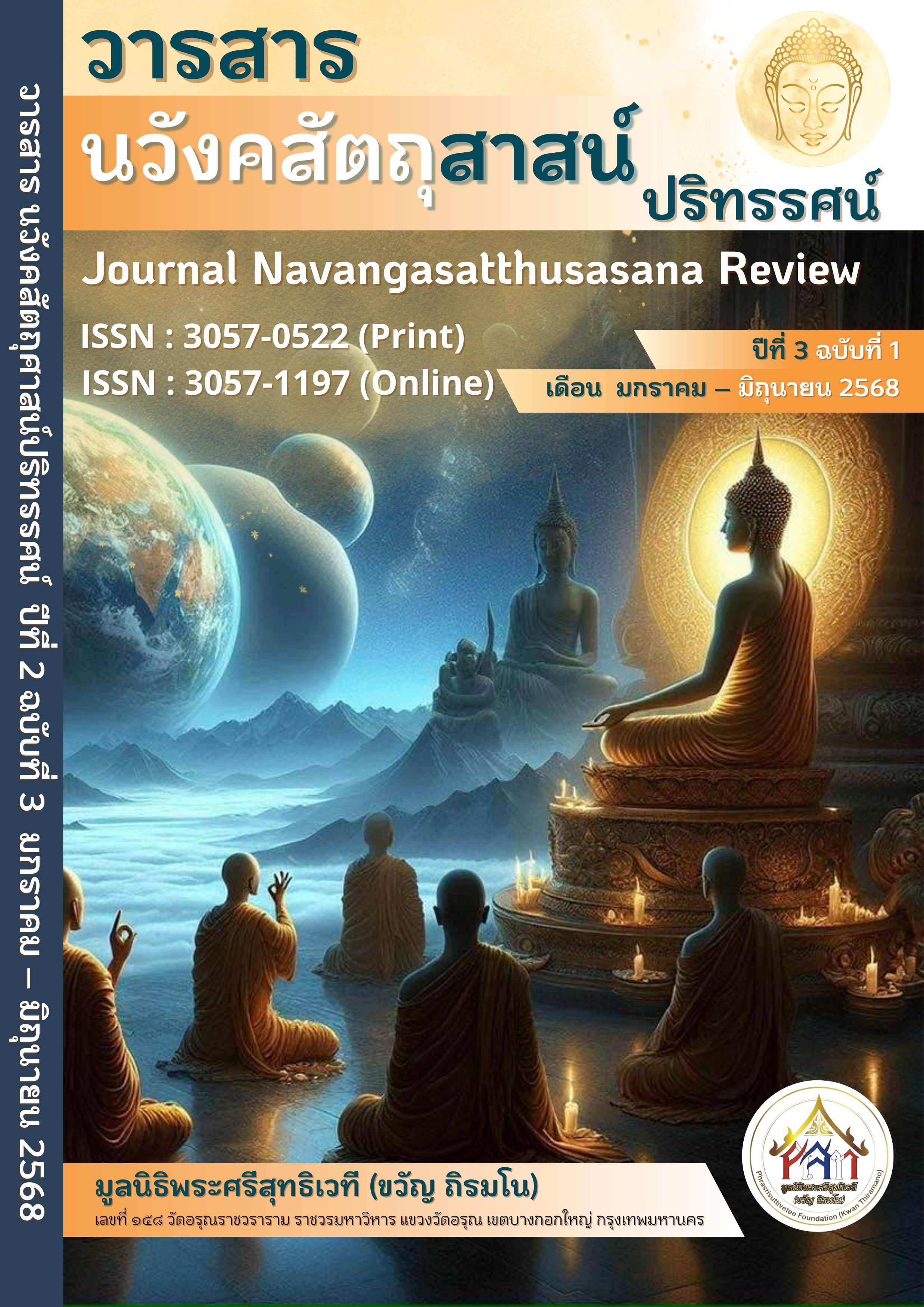บูรณาการหลักธรรมในการทำงานของบุคลากรตามหลักราชวสดีธรรม
Main Article Content
บทคัดย่อ
บทความนี้มีจุดประสงค์เพื่อศึกษาหลักราชวสดีธรรมที่นำมาบูรณาการกับการทำงานของบุคลากรอันเป็นแนวทางในการปฏิบัติภาระหน้าที่ตามที่ได้รับมอบหมายเพื่อพัฒนาตนเองและองค์กรพระพุทธเจ้าทรงแสดง “ราชวสดีธรรม” คือหลักธรรมที่ว่าด้วยการปฏิบัติหน้าที่ต่อพระราชา จำนวน 49 ประการ เมื่อว่าโดยรวมมี 3 ด้านใหญ่ ๆ คือ 1) การปฏิบัติตนต่อพระเจ้าแผ่นดินโดยตรง 2) การควบคุมตนเองของข้าราชการ 3) การทำงานโดยตรง เป็นเรื่องที่ยึดถือปฏิบัติกันเป็นธรรมเนียมข้าราชการมาแต่โบราณ เป็นหลักการปฏิบัติหน้าที่ของข้าราชการในฐานะผู้รับใช้พระราชา ซึ่งเป็นหลักปฏิบัติที่ใช้กับผู้ใต้ปกครอง แต่ก็สามารถนำมาบูรณาการใช้กับองค์กรหรือหน่วยงานต่าง ๆ ได้
สาระคำสอนราชวสดีธรรมหมวดที่ 3 นอกจากจะเป็นวรรณกรรมทางพระพุทธศาสนาแล้ว ยังมีความสำคัญในฐานะของวรรณกรรมคำสอนที่มุ่งสอนข้าราชการหรือบุคลากรขององค์กรต่าง ๆ ให้มีแนวทางการประพฤติปฏิบัติตนตามภาระหน้าที่ที่รับผิดชอบ เช่น พึงเป็นผู้ได้รับการฝึกฝนศิลปศาสตร์จนมีความรู้ความสามารถที่จะปฏิบัติหน้าที่ได้โดยไม่บกพร่อง พึงเป็นผู้มีความอ่อนน้อมถ่อมตน เป็นต้น เมื่อกล่าวโดยสรุป หลักราชวสดีธรรมในหมวดที่ 3 เป็นการแสดงถึงคุณลักษณะที่ดีของ ข้าราชการ บุคลากรในองค์กรต่าง ๆ ซึ่งเป็นคุณลักษณะที่ต้องการและเป็นที่ยอมรับของสังคม การนำสาระคำสอน “ราชวสดีธรรม” มาใช้กันอย่างต่อเนื่องทั้งในรูปวรรณกรรมคำสอน การเขียนแทรกในวรรณคดี หรือตำรา รวมถึงกรอบที่นำมาตราขึ้นเป็นกฎหมายเป็นเครื่องบ่งชี้ว่าสาระคำสอน “ราชวสดีธรรม” ยังคงเป็นที่ยอมรับอยู่ในสังคมไทยเรื่อยมาตั้งแต่อดีตจนถึงปัจจุบัน จึงเป็นจำเป็นอย่างยิ่งที่บุคลากรในองค์กรต่าง ๆ ควรนำมาประพฤติปฏิบัติให้เป็นปกติชีวิตในการปฏิบัติหน้าที่อันจะเป็นเหตุนำมาซึ่งความเจริญงอกงามไพบูลย์ทั้งตนเองและองค์กร
Article Details

อนุญาตภายใต้เงื่อนไข Creative Commons Attribution-NonCommercial-NoDerivatives 4.0 International License.
เนื้อหาและข้อมูลในบทความที่ลงตีพิมพ์ในวารสาร นวังคสัตถุสาสน์ปริทรรศน์ถือเป็นข้อคิดเห็นและความรับผิดชอบของผู้เขียนบทความโดยตรงซึ่งกองบรรณาธิการวารสาร ไม่จำเป็นต้องเห็นด้วย หรือร่วมรับผิดชอบใด ๆ บทความ ข้อมูล เนื้อหา รูปภาพ ฯลฯ ที่ได้รับการตีพิมพ์ในวารสาร นวังคสัตถุสาสน์ปริทรรศน์ถือเป็นลิขสิทธิ์ของวารสาร นวังคสัตถุสาสน์ปริทรรศน์หากบุคคลหรือหน่วยงานใดต้องการนำทั้งหมดหรือส่วนหนึ่งส่วนใดไปเผยแพร่ต่อหรือเพื่อกระทำการใด ๆ จะต้องได้รับอนุญาตเป็นลายลักอักษรจากวารสาร นวังคสัตถุสาสน์ปริทรรศน์ก่อนเท่านั้น
เอกสารอ้างอิง
กิติพันธ์ รุจิรกุล, พฤติกรรมผู้นำทางการศึกษา, กรุงเทพมหานคร: โอ.เอส พริ้นติ้งเฮ้าส์, 2529.
ดารณี จุนเจริญวงศา, การจัดการความรู้, ชลบุรี: สำนักงาน ป้องกันควบคุมโรคที่ 3 จังหวัด ชลบุรี กลุ่มส่งเสริมสนับสนุนวิชาการ. ถ่ายเอกสาร, 2548.
นพพงษ์ บุณจิตราดุลย์, หลักการบริหารการศึกษา, กรุงเทพมหานคร: ศูนย์การพิมพ์, 2529.
เบญจมาศ อยู่เป็นแก้ว, การสอนแบบบูรณาการ Integrated Instruction. พิมพ์ครั้งที่ 3, กรุงเทพมหานคร: โรงพิมพ์ภาพพิมพ์, 2548.
พระโมคคัลลานมหาเถระ. อภิธานปฺปทีปิกา และ อภิธานปฺปทีปิกา สูจิ. กรุงเทพมหานคร: โรงพิมพ์มหามกุฏราชวิทยาลัย, 2535.
พิมพันธ์ เดชะคุปต์และเยาว์ ยินสุขดี, ทักษะ 5 C เพื่อการพัฒนาหน่วยการเรียนรู้และการจัดการเรียนการสอนแบบบูรณาการ. กรุงเทพมหานคร: โรงพิมพ์จุฬาลงกรณ์มหาวิทยาลัย, 2548.
พุทธทาสภิกขุ, คู่มือมนุษย์ (ฉบับคาสมบูรณ์), กรุงเทพมหานคร: สานักพิมพ์ธรรมสภา, 2543.
มหาจุฬาลงกรณราชวิทยาลัย. พระไตรปิฎกบาลี ฉบับมหาจุฬาเตปิฏกํ 2500. กรุงเทพมหานคร: โรงพิมพ์มหาจุฬาลงกรณราชวิทยาลัย, 2535.
มหาจุฬาลงกรณราชวิทยาลัย. ปกรณวิเสสภาษาบาลี ฉบับมหาจุฬาปกรณวิเสโส. กรุงเทพมหานคร:
มหาจุฬาลงกรณราชวิทยาลัย. พระไตรปิฎกภาษาไทย ฉบับมหาจุฬาลงกรณราชวิทยาลัย. กรุงเทพมหานคร : โรงพิมพ์มหาจุฬาลงกรณราชวิทยาลัย, 2539.
มหาจุฬาลงกรณราชวิทยาลัย. อรรถกถาภาษาบาลี ฉบับมหาจุฬาอัฏฐกถา. กรุงเทพมหานคร: โรงพิมพ์ วิญญาณ, 2539.
โรงพิมพ์วิญญาณ, 2539-2543.
วิเศษ ชินวงศ์, การจัดการเรียนการสอนแบบบูรณาการ. วารสารวิชาการ, 10 ตุลาคม 2544.
สิริพัชร์ เจษฎาวิโรจน์, การพัฒนาหลักสูตรบูรณาการสำหรับนักเรียนชั้นประถมศึกษาปีที่ 1 โรงเรียนวัดเสมียนนารีกรุงเทพมหานคร. วิทยานิพนธ์ศึกษาศาสตรดุษฎีบัณฑิต (หลักสูตรและการสอน) มหาวิทยาลัยเกษตรศาสตร์, 2549.
อรัญญา สุธาสิโนบล, แนวคิดในการจัดการเรียนการสอนแบบบูรณาการ. วารสารวิชาการ, ปีที่ 5, 2552.
J.W. Getzels, Creativity and Intelligence: Exploration with Gifted Students, New York: Wiley, 1957.


